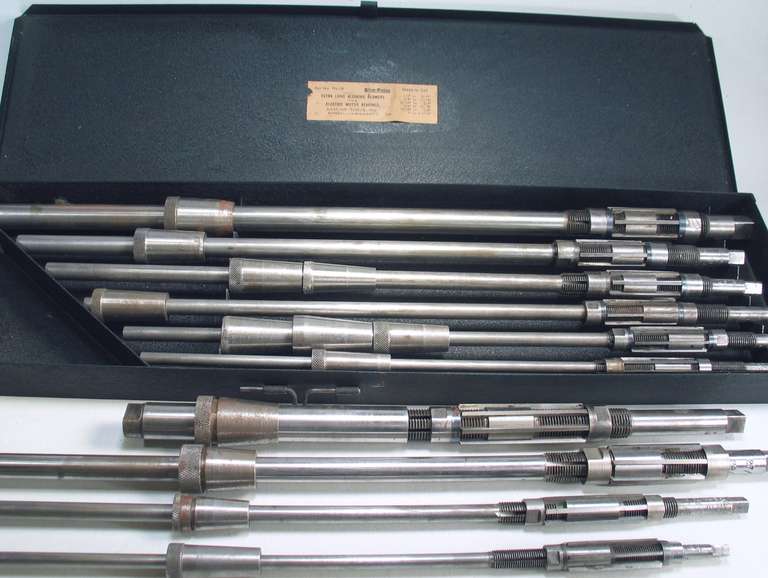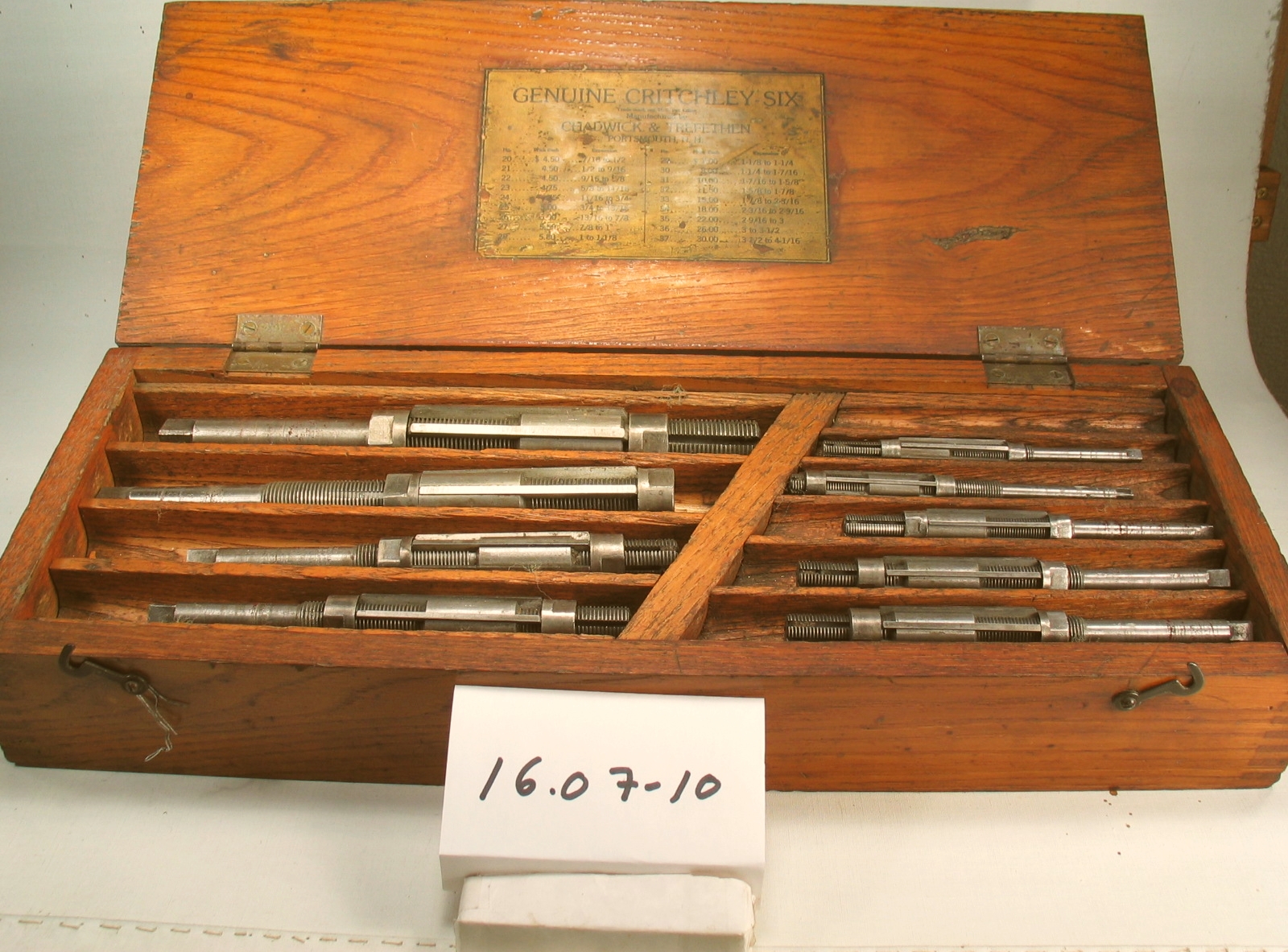16.07-11: 1958 Extra Long, Alignment Bearing Reamers

| HHCC Accession No. 2006.219 | HHCC Classification Code: 16.07-11 |
|---|
Description:
Set of 6 blade, extra long, alignment bearing reamers, six in Snap-On, Blue Point case, sizes from ‘ to 1 1/16; with four supplementary reamers to extend range from 9/16 to 15/16, all with tapered self-alignment pilots, used in HVACR equipment repair shop for the fitting of FHP electric motor bearings, in the 1950’s through 1960’s, Variously made by Snap-On, Joborn and Webco, Circa 1958
Group:
16.07 Electric Motors - Installation, Test and Repair
Make:
Variously, made by Snap-On, Joborn and Webco
Manufacturer:
Model:
Blue point RL-19
Serial No.:
Size:
22 x 6 x 3.5 inches h.
Weight:
16 lbs.
Circa:
1958
Rating:
Exhibit, education, and research quality, illustrating mid 20th century, specialized bearing, alignment, reamer tool technology, developed for fitting sleeve bearings on FHP electric motors.
Patent Date/Number:
Provenance:
From York County (York Region) Ontario, once rich agricultural hinterlands, attracting early settlement in the last years of the 18th century. Located on the north slopes of the Oak Ridges Moraine, within 20 miles of Toronto, the County would also attract early ex-urban development, to become a wealthy market place for the emerging household and consumer technologies of the early and mid 20th century.
This artifact was discovered in the 1950’s in the used stock of T. H. Oliver, Refrigeration and Electric Sales and Service, Aurora, Ontario, an early worker in the field of agricultural, industrial and consumer technology.
Type and Design:
Six blade, hand reamer technology, Employing extra long alignment bearing reamers, All with tapered, self-alignment pilots Six in Snap-On Blue Point; case RL-19, ‘ to 1 1/16 Four supplementary reamers in extended ranges in sizes from 9/16 - 5/8, 19/32’’ 21/32’, 27/32’ ‘ 29/32’, and 27/32’ ‘ 15/16’.
Construction:
Material:
Special Features:
Several reamers have had additional custom made, tapered , self-alignment pilots, shop turned to meet the specifications of certain motors with differences in bearing sizes - out side the range provided by the manufacturer. A marker of the range of skills and equipment possessed by some specialized HVACR repair shops of the period.
Accessories:
Capacities:
Performance Characteristics:
Operation:
Control and Regulation:
Targeted Market Segment:
Consumer Acceptance:
Merchandising:
Market Price:
Technological Significance:
These mid 20th century, alignment, bearing reamers tell many stories of their time: The arrival of bearing tools which would yield much greater precision in bearing fitting required for newly emerging equipment, operating at higher speeds and requiring close operating tolerances - especially electric motors [see ID # 340, 16.07-8], The critical step forward for the HVACR maintenance and repair sector, which came with the availability of hand alignment reamers, especially made for the FHP electric motor repair shops ‘ at a price they could afford.
The critical role played by the lowly bronze, sleeve bearing in helping to ensure the operating performance and reliability of the FHP electric motor ‘ on which much household, commercial and industrial technology would come to depend starting in the 1920’s. The FHP induction motor, for the most part, would have only two moving parts, as it evolved through the 1930 to 60’s, its starting mechanism and its bearing structure. It was a period before advances in metallurgy and applications engineering made the long life, sleeve bearing a reality [See Reference 1]. Both starting mechanisms and bearings were subject to rapid wear and often early failure. The engineering, maintenance and repair of both were critical to the performance and reliability of HVACR equipment in both household and commercial applications.
Industrial Significance:
The Snap-On, Blue-Point metal case, with blue wrinkled enamel finish, and stylish company logo in red and white is an industrial design icon of the period. Gone was the heavy, hand crafted, oak case, preferred by the market of a decade or so earlier, to be replaced by a much slicker, streamlined and modern look preferred by Canada’s post W.W.II economy and culture [See ID # 342, 16.07-10].
The well equipped HVACR repair and rebuilding shop of the time would be one well equipped to replace, refit and re-machine electric motor bearings, employing hand fitting and reaming equipment [See also ID No, 341, 16.07-9, and 343, 16.07-11]. The arrival in the market place of the alignment reamer, custom made for the FHP electric motor repair industry was, in itself, a marker of some significance. What it marked was the size of the motor repair sector of the times, and the market opportunities presented, in meeting the tooling needs of HVACR repair industry.
In hindsight, it was with a certain irony that the long pattern, hand, alignment reamer would be welcomed into the life of the HVACR mechanic. For while it marked a major step forward in dealing with bearing failures of the time, it also marked the end of an era. As the 1950’s came to an end, three factors would converge to dramatically restructure the HVACR service industry: The hermetic motor compressor would, within a few short years, come to dominate in the field of household and commercial refrigeration applications, effectively mitigating the need for the open, belt driven refrigeration system;
For other applications the evolution of new metallurgy and bearing designs would yield bearing structures whose life expectancy could be measured in decades rather than months and years; and Constantly rising labour costs, coupled with reduced production costs would spell the end to much of the FHP electric motor repair industry. The HVACR service technician would become much more of a diagnostician and replacement technician than a repairman.
Socio-economic Significance:
Socio-cultural Significance:
Donor:
G. Leslie Oliver, The T. H. Oliver HVACR Collection
HHCC Storage Location:
Tracking:
Bibliographic References:
‘Fractional Horsepower Electric Motors’, Cyril G. Veinott, McGraw-Hill, 1948. Chapter XVIII, P 415.









